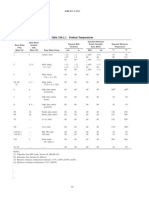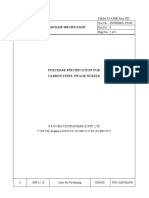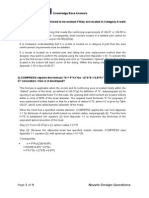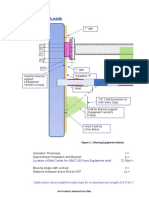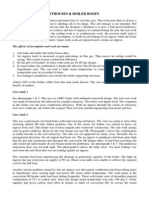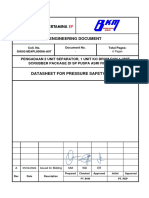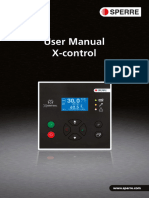Npe3 2 02 Asme2004
Npe3 2 02 Asme2004
Uploaded by
Tiu TonCopyright:
Available Formats
Npe3 2 02 Asme2004
Npe3 2 02 Asme2004
Uploaded by
Tiu TonOriginal Description:
Original Title
Copyright
Available Formats
Share this document
Did you find this document useful?
Is this content inappropriate?
Copyright:
Available Formats
Npe3 2 02 Asme2004
Npe3 2 02 Asme2004
Uploaded by
Tiu TonCopyright:
Available Formats
Part A2
CHAPTER 2
Code Calculations ASME Section I
Here is what you w i l l be able to do when you complete each objective: 1. Given the tube material specification numbers, and other necessary parameters, use the formulae in PG-27.2.1 to calculate either the minimum required wall thickness or the maximum allowable working pressure for a boiler tube. 2. Given the material specification, construction method, and other necessary parameters, use the formulae in PG-27.2.2 to determine the required thickness and or maximum working pressure for boiler drums, headers, or piping. 3. Given the required specifications and operating conditions, use formula PG29.1 to calculate the required thickness of a seamless, unstayed dished head. 4. Given the design and the steam generation capacity of a boiler, read
the information in paragraphs PG-67 to PG-71 and understand the effect of these paragraphs on a specific boiler.
Note: All information and questions posed in this module utilize formulae and figures found in the 2004 ASME Academic Extract.
REVISED OCTOBER 2005
Chapter 2 Code Calculations ASME Section I
37
OBJECTIVE 1
Given the tube material specification numbers, and other necessary parameters, use the formulae in PG-27.2.1 to calculate either the minimum required wall thickness or the maximum allowable working pressure for a boiler tube.
SYMBOLS USED IN THE FORMULAE OF PG-27
The symbols in the formulae to be used in this module are found in Paragraph PG-27.3 and are defined as follows. It is extremely important that the correct units be applied when performing the calculations: t P D R E = = = = = minimum required thickness (millimetres, mm). (Also see PG-27.4, Note 7) maximum allowable working pressure (megapascals, MPa). (Note - this refers to gauge pressure) outside diameter of cylinder (millimetres, mm) inside radius of cylinder (millimetres, mm) efficiency of longitudinal welded joints or of ligaments between openings, whichever is lower. The values allowed for E are listed in PG-27.4, Note 1. This is a factor that has no units, (for example, the value of E for seamless cylinders is 1.00) maximum allowable stress value, at the operating temperature of the metal, as listed in the Section II, Part D, Table 1A, (megapascals, MPa). See PG-27.4, Note 2. The tables are located in an Section II, Part D at the back of the 2004 ASME Academic Code Extract. Each table spans four pages. Reference the line number on the first page to follow along each page until you find the correct temperature value required. minimum allowance for threading and structural stability, (millimetres, mm). See PG-27.4, Note 3 thickness factor for expanded tube ends (millimetres, mm). See PG-27.4, Note 4 a temperature coefficient: This factor has no units and has a value between 0.4 and 0.7. The values allowed for y are listed in PG-27.4, Note 6, (for example, for ferritic steel at 550C, the value of y is 0.7)
C e y
= = =
38
A2 Third Class SI Units
BOILER TUBE CALCULATIONS
To calculate the required minimum wall thickness or the maximum allowable working pressure of ferrous boiler tubing, up to and including 125 mm O.D., the following formulae, as given in PG-27.2.1, are used: Minimum thickness: t =
PD + 0.005 D + e 2S + P
2 t - 0.01 D - 2 e Maximum pressure: P = S D - ( t - 0.005 D - e )
Example 1 (to find tube wall thickness): Calculate the minimum required wall thickness of a superheater tube. The tube is 76 mm O.D. and is connected to a header by strength welding. The maximum allowable working pressure is 4150 kPa gauge and the average tube temperature is 400C. The tube material is alloy steel with specification SA-213-T11. Solution: From PG-27.2.1, the formula to use is:
t =
PD + 0.005 D + e 2S + P
First, find all the required factors for the formula: given that: P = 4150 kPa = 4.15 MPa D = 76.0 mm from Codes: e = 0 (from PG-27.4, Note 4, strength welded) S = 102 MPa = stress value at 400C for SA-213, T-11 *
*Note: This 102 MPa value for S is found in Section II, Part D, Table 1A, SA-
213, T-11. First locate the specification number, SA-213 T11, in the column under the headings Spec. No. and Type/Grade (page 267 of extract). Then scan across the table pages to page 269 the 400 column under Maximum Allowable Stress, MPa, for Metal Temperatures, C, Not Exceeding The corresponding value is 102 MPa.
Chapter 2 Code Calculations ASME Section I
39
Now, complete the calculation by substituting all factors into the formula:
t =
4.15 76 + 0.005 76 + 0 2 102 + 4.15 315.4 + 0.38 208.15
1.90 mm (Ans.)
= =
Information concerning the type of material used and the construction of the tube can be found in PG-9. The student should check PG-6 and PG-9 before starting calculations. The information in these sections will help direct the student to the correct section of Section II, Part D, Table 1A by indicating if the metal is carbon steel, low alloy steel, or high alloy steel. PG-6 deals with steel plate, PG-9.1 deals with boiler tubes or pressure containing parts, PG-9.2 deals with all superheater parts. These sections will also help to correctly select the values for E and e (as per PG-27, Note 1 and Note 6). Note: This value for the thickness of the tube is exclusive of manufacturers tolerances. (See PG-16.5) Example 2 (to find maximum allowable working pressure): Calculate the maximum allowable working pressure, in kPa, for a watertube boiler tube, which is 73.5 mm O.D. and has a minimum wall thickness of 4.71 mm. The tube is strength-welded into place in the boiler and is located in the furnace area of the boiler. Tube material is carbon steel, SA-192, with a mean wall temperature of 280C. Solution: From PG-27.2.1, the formula to use is:
2 t - 0.01 D - 2 e P = S D - ( t - 0.005 D - e )
First, find all the required factors for the formula: given that: t = 4.71 mm D = 73.5 mm
40
A2 Third Class SI Units
from Codes:
e = 0 (from PG-27.4, Note 4) S = 84.3 MPa = stress value at 375 C for SA-192, carbon steel *
*Note: This 84.3 MPa value for S is found in Section II, Part D, Table 1A.
Now, find SA-192 in the table and scan across to find the temperature. Youll notice that there is no column for 370C, so take the next higher temperature, which is 375C. Use the value of 84.3 MPa from this column. Note: In general, when a temperature given in a problem does not appear in Section II, Part D, Table 1A, select the next higher temperature from the table DO NOT INTERPOLATE BETWEEN VALUES.
Now, substitute the values of all factors into the formula:
( 2 4.71) - ( 0.01 73.5 ) - ( 2 0 ) P = 84.3 73.5 - ( 4.71- 0.005 73.5 - 0 ) 9.42 - 0.735 - 0 = 84.3 73.5 - ( 4.71- 0.3675 ) = 10.62 MPa (Ans.)
In both Example 1 and Example 2, the tubes were strength-welded into place. In this case the value of e is zero. In calculations involving tubes expanded into place, the appropriate value of e would be inserted into the formula. (See PG27.4, Note 4)
Chapter 2 Code Calculations ASME Section I
41
OBJECTIVE 2
Given the material specification, construction method, and other necessary parameters, use the formulae in PG-27.2.2 to determine the required thickness and or maximum working pressure for boiler drums, headers, or piping.
PIPING, DRUM AND HEADER CALCULATIONS
PG-27.2.2 (see page 7 of the 2004 ASME Codes Extract) gives the formulae that are used to calculate the required minimum thickness or the maximum allowable working pressure of ferrous piping, drums, and headers. The size of each component may be stated as the outside diameter or as the inside radius. The formulae that are applied differ in each case, and are as follows: To find the minimum thickness
If the outside diameter is given, use: t = PD +C 2 SE + 2 y P
If the inside radius is given, use: t = PR +C SE - (1 - y ) P
To find the maximum working pressure
If the outside diameter is given, use: P =
2 SE (t - C ) D - 2 y (t - C )
If the inside radius is given, use: P = SE (t - C ) R + (1- y )(t - C )
42
A2 Third Class SI Units
Example 3 (to find the required thickness of a boiler drum): Calculate the minimum required thickness, in mm, of a welded boiler drum having an inside diameter of 1.5 m. The drum welds are finished flush with the surface of the plate. The drum plate is carbon steel, SA-516-65, and the metal temperature will not exceed 250C. The maximum allowable working pressure is 4500 kPa gauge. The efficiency of the ligaments between the tube holes is 0.5. Solution: The inside diameter is given and therefore the formula from PG-27.2.2, for inside radius can be used can be used: t = PR + C SE - (1 - y ) P 4500 kPa gauge = 4.5 MPa D/2 = 0.75 m = 750 mm
given that: P = R =
E = 0.5 from Codes: C = 0 (from PG-27.4, Note 3: drum is larger than 100 mm) S = 128 MPa (Section II, Part D, Table 1A for SA-516-65 at 250C) y = 0.4 (PG-27.4, Note 6, ferritic at temperature below 480C) substituting these values into the equation: t = PR +C SE - (1 - y ) P
= = =
4.5 750 +0 128 0.5 - (1 - 0.4) 4.5 3375 64 - (0.6) 4.5 3375 61.3
= 55.06 mm (Ans.)
Chapter 2 Code Calculations ASME Section I
43
Example 4 (to find the maximum working pressure of a boiler drum): Calculate the maximum allowable working pressure for a welded drum if the plates are 25 mm thick and of material SA-299. The inside diameter of the drum is 988 mm and the joint efficiency is 100%. Assume the steam temperature will not exceed 400C. Solution: The inside diameter is given and therefore the formula from PG-27.2.2, for inside radius, can be used; P = given that: S E (t - C ) R + (1 - y ) (t - C )
t = 25 mm R = D/2 = 494.0 mm E = 1.0 (PG-27.4, Note 3)
from Codes: C = 0 (from PG-27.4, Note 3) S = 107 MPa (Section II, Part D, Table 1A for SA-299 at 400C) y = 0.4 (PG-27.4, Note 6, temperature less than 400C) substituting these values into the equation: P = SE (t - C ) R + (1- y )(t - C )
=
=
107 1(25 - 0) 494 + (1- 0.4)(25 - 0) 2675 509
= 5.26 MPa (Ans.)
44
A2 Third Class SI Units
Example 5 (to find the required thickness of a header): Calculate the required thickness, in mm, of a superheater outlet header, operating at 500C and having a maximum allowable working pressure of 17 MPa. The header material is SA-335-P5 and the outside diameter is 457.2 mm. Solution: The outside diameter is given and therefore the formula from PG-27.2.2, for outside diameter should be used: PD t = + C 2 SE + 2 yP given that: P = 17.0 MPa D = 457.2 mm from Codes: C = 0 (from PG-27.4, Note 3) S = 61.7 MPa (Section II, Part D, Table 1A for SA-335-P5 at 500C) y = 0.5 (PG-27.4, Note 6) E = 1.0 (PG-27.4 Note 1) substituting these values into the equation: t = PD +C 2SE + 2 yP 17 457.2 = +0 ( 2 61.7 1) + ( 2 0.5 17 )
7772.4 140.4
= 55.36 mm (Ans.)
Chapter 2 Code Calculations ASME Section I
45
Example 6 (to find the required thickness of a high-pressure boiler pipe): Calculate the minimum thickness required for a seamless steel feedwater pipe of material SA-209, grade T1. The outside diameter of the pipe is 323.85 mm and the operating pressure and temperature are 5200 kPa and 500C respectively. The pipe is plain-ended. Assume that the material is an austenitic steel. Note: Plain-end pipe is that which does not have its wall thickness reduced when joined to another pipe. For example, pipe lengths welded together rather than joined by threading are classed as plain-end pipes. Solution: The outside diameter is given and therefore the formula from PG-27.2.2, for outside diameter should be used: PD t = +C 2SE + 2 yP given that: P = 5.2 MPa D = 323.85 mm from Codes: C = 0 (from PG-27.4, Note 3; 4 inch nominal and larger) S = 72.1 MPa (Section II, Part D, Table 1A for SA-209-T1, at 500C) y = 0.4 (PG-27.4, Note 6; austenitic steel at 500C) E = 1.0 (PG-27.4 Note 1; seamless pipe as per PG-9.1) substituting these values into the equation: t =
=
PD +C 2SE + 2 yP
5.2 323.85 +0 ( 2 72.11) + ( 2 0.4 5.2 )
1684.02 148.36 = 11.35 mm (Ans.)
46
A2 Third Class SI Units
Note on Manufacturers Tolerance: The calculated thickness in Example 6 does not include the manufacturers tolerance. Since the manufacturing process does not produce absolutely uniform wall thickness, an allowance is added, which is called the manufacturing tolerance. This is usually done by increasing the minimum required thickness, as calculated in the formula, by 12.5%. Example 7 (for minimum thickness of steam piping): Calculate the required minimum thickness (in mm) of steam piping which will carry steam at a pressure of 4300 kPa gauge and a temperature of 370C. The piping is plain-end, 273.05 mm O.D.; the material is low alloy steel, SA-335 P11. A manufacturers tolerance of 12.5% must be added to the pipe. Solution: The outside diameter is given and therefore the formula from PG-27.2.2, for outside diameter should be used: t = PD +C 2SE + 2 yP
given that: P = 4.3 MPa D = 273.05 mm from Codes: C = 0 (from PG-27.4, Note 3) S = 104 MPa (Section II, Part D, Table 1A for SA-335-P11, at 370C) y = 0.4 (PG-27.4, Note 6; ferritic steel at 475C) E = 1.0 (PG-27.4 Note 1) substituting these values into the equation: t = PD +C 2SE + 2 yP 4.3 273.05 = +0 ( 2 104 1) + ( 2 0.4 4.3)
1174.12 = 5.55 mm 211.44
multiply by 1.125 to add the manufacturers tolerance of 12.5%:
t = 5.55 x 1.125 = 6.24 mm (Ans.)
Chapter 2 Code Calculations ASME Section I
47
OBJECTIVE 3
Given the required specifications and operating conditions, use formula PG-29.1 to calculate the required thickness of a seamless, unstayed dished head.
DISHED HEAD CALCULATIONS
The following Paragraphs from PG-29 must be considered when performing calculations on dished heads.
Paragraph PG-29.1 states that the thickness of a blank, unstayed dished head with the pressure on the concave side, when it is a segment of a sphere, shall be calculated by the following formula: t
5PL 4.8S
The symbols in this formula are defined as follows: t = minimum thickness of plates (mm)
P = maximum allowable working pressure (MPa) L = radius (mm) to which the head is dished, measured on the concave side mm S = maximum allowable working stress (MPa), using values Section II, Part D, Table 1A Paragraph PG-29.2 states: The radius to which the head is dished shall be not greater than the outside diameter of the flanged portion of the head. If two different portions of the head are dished to different radii, then the longer radius shall be used as the value of L in the formula. Paragraph PG-29.3 states that when a head, dished to a segment of a sphere, has a flanged-in manhole or access opening that exceeds 6 in. (150 mm) in any dimension, then its thickness must be 15%, or no
48
A2 Third Class SI Units
case less than 1/8 in. (3.0 mm), additional thickness over a blank head. As calculated by the formula in PG-29.1. Note: This would apply to a manhole such as is found on the end of a boiler drum.
Paragraph PG-29.5 states that in the case of a dished head with a flanged-in manhole, if the dish radius L is less than 80% of the diameter of the shell to which the head is attached, then, when calculating the thickness by: t
5PL 4.8S
the value of L must be made equal to 80% of the shell diameter. In addition, the thickness thus calculated must be increased by the greater of 15% or 3.0 mm (PG-29.3) to compensate for the flangedin manhole. This method of calculation will give the minimum thickness for any form of head having a flanged-in manhole.
Paragraph PG-29.6 states that no head, except a full-hemispherical head, shall be of lesser thickness than required for a seamless shell of the same diameter.
Example 8: Calculate the thickness of a seamless, unstayed dished head with pressure on the concave side, having a flanged-in manhole 280 mm by 380 mm. The head has a diameter of 1235 mm and is a segment of a sphere with a dish radius of 1016 mm. The maximum allowable working pressure is 1380 kPa, the material is SA285 C and the metal temperature does not exceed 204C. Solution: First thing to check: Is the radius of the dish at least 80% of the radius of the shell, per PG-29.5? 1016/1235 = 0.823 = 82.3 % This is greater than 80%, so the value of L in the formula will be 1016 mm. Use the formula from PG-29.1: t
5PL 4.8S
Chapter 2 Code Calculations ASME Section I
49
given that: P = 1.380 MPa L = 1016 mm (radius of the curvature of the sphere) from Codes: S = 108 MPa (Section II, Part D, Table 1A for SA-285-C, at 250 C) substituting these values into the equation: t
5PL 4.8S 5 1.380 1016 4.8 108
= 13.52 mm
This would be the thickness of a blank head, that is a head with no manhole. In this case there is a manhole and it exceeds the 152 mm allowed by PG-29.3. Therefore, the thickness must be increased by 15% or by 3.0 mm whichever is greater. 15% of 13.52 mm = 0.15 x 13.52 = 2.028 mm But this is less than 3.0 mm, so the thickness must be increased by 3.0 mm. Therefore, the required thickness is: 13.52 mm + 3.0 mm = 16.52 mm (Ans.) Example 9: Calculate the thickness of a seamless, blank unstayed dished head having pressure on the concave side. The head has a diameter of 1067 mm and is a segment of a sphere with a dish radius of 915 mm. The maximum allowable working pressure is 2068 kPa and the material is SA-285 A. The metal temperature does not exceed 250C.
50
A2 Third Class SI Units
Solution: First thing to check: Is the radius of the dish at least 80% of the radius of the shell, per PG-29.5? 915/1067 = .857 = 85.7% This is greater than 80%, so the value of L in the formula will be 915 mm. Use the formula from PG-29.1: t
5PL 4.8S
given that: P = 2.068 MPa L = 915 mm (radius of the curvature of the sphere) from Codes: S = 88.9 MPa (Section II, Part D, Table 1A for SA-285 A, at 250C) substituting these values into the equation: 5 2.068 915 t = 4.8 88.9 = 22.17 mm From PG-29.6, the head in this example must be as thick as, or thicker than, a seamless shell of the same diameter. Therefore, before we can confirm that the calculated thickness of 22.17 mm is adequate, we must determine the shell thickness. Calculate the shell thickness using the appropriate formula from PG-27.2.2 where: C = 0 y = 0.4 t =
t =
then:
PD +C 2S + 2 yP
2.068 1067 +0 ( 2 88.9 ) + ( 2 0.4 2.068)
= 12.30 mm
Since 25.27 is greater than 12.30 mm, the head thickness of 22.17 mm, as calculated before, is adequate.
Chapter 2 Code Calculations ASME Section I
51
Example 10: Calculate the thickness of the head in Example 9 if it has a flanged-in manhole. Solution: The thickness of the blank head in Example 2 is equal to 22.17 mm. According to PG-29.3, this thickness must be increased by the greater of 3.0 mm or 15%. 22.17 mm x 0.15 = 3.33 mm
Since this is greater than 3.0 mm, increase the thickness by 3.33 mm: Head thickness = 22.17 mm + 3.33 mm = 25.50 mm (Ans.)
52
A2 Third Class SI Units
OBJECTIVE 4
Given the required specifications and operating conditions, use formulae in paragraphs PG-29.11 and PG-29.12 to calculate the required thickness of an unstayed, full-hemispherical head.
HEMISPHERICAL HEAD CALCULATIONS
When a boiler head is in the form of a complete hemi-sphere, termed fullhemispherical, the requirements of Paragraph PG-29.11 apply. This paragraph states that the minimum required thickness for a blank, unstayed, fullhemispherical head with the pressure on the concave side shall be calculated by one the following two formulae: t
PL 2S - 0.2 P
The above formula should not be uses when the required thickness of the head given by the formula exceeds 35.6% of the inside radius and is used for shells or headers that are designed according to PG-27.2.2, and if the head is integrally formed on a seamless shell.
Paragraph PG-29.12 states if a flanged-in manhole, meeting code requirements, is placed in a full-hemispherical head, then the thickness of the head is calculated using the same formula as for a head dished to the segment of a sphere (per PG-29.1 and PG-29.5), with a dish radius equal to 80% of the shell diameter and with the added thickness for the manhole (per PG-29.3). That is, the following formula is used, where the value of L in the formula is 80% of the diameter of the shell. t
5PL 4.8S
Chapter 2 Code Calculations ASME Section I
53
Example 11: Calculate the minimum required thickness, in mm, for a blank, unstayed, fullhemispherical head, with the pressure on the concave side. The head is fabricated from seamless material and is double butt welded to the shell. All reinforcement is removed and fully radiographed. The radius to which the head is dished is 700 mm, maximum allowable working pressure is 4000 kPa, and the head material (SA-285 C) will not reach a temperature greater than 340C Solution: Use the formula from PG-29.11: t
PL 2S - 0.2 P
given that: P = 4.0 MPa L = 700 mm (radius of the curvature of the head) from Codes: S = 101 MPa (Section II, Part D, Table 1A for SA-285 C, at 350 C) substituting these values into the equation:
t =
4.0 700 ( 2 101) ( 0.2 4 )
= 13.92 mm (Ans)
Example 12: A seamless, welded, full-hemispherical head is welded to a boiler shell that has an inside diameter of 1100 mm. Maximum working pressure is 3500 kPa, the material is SA-226 1, and operating temperature is 300C. The head has a flanged in manhole that meets code requirements. Calculate the minimum required thickness for the head. Solution: With this question PG-29.12 applies. Therefore use the formula from PG-29.1: (per PG-29.12) t =
5 PL 4.8 S
given that: P = 3.5 MPa from codes: S = 107 MPa (Section II, Part D, Table 1A for SA-226, at 300C)
54
A2 Third Class SI Units
L = 880 mm (80% of 1100 mm per PG-29.1) substituting these values into the equation:
5 3.5 880 4.8 107
= 29.98 mm From PG-29.3, due to the manhole, this thickness calculation must be increased by the greater of 15% or 3.0 mm. 29.98 mm x 0.15 = 4.50 mm Since this is greater than 3.0 mm, the thickness must be increased by this amount: t = 29.98 mm + 4.50 mm = 34.48 mm (Ans.)
Chapter 2 Code Calculations ASME Section I
55
OBJECTIVE 5
Given the design and the steam generation capacity of a boiler, read the information in paragraphs PG-67 to PG-71 and understand the effect of these paragraphs on a specific boiler.
PG-67 PG-72: SAFETY VALVES (and Safety Relief Valves)
Paragraphs PG-67 to PG-72 of ASME Code, Section 1, deal with safety valves and safety relief valves. In particular, these sections cover the following topics:
PG-67 Boiler Safety Valve Requirements: the types and numbers of safety valves required on the various types of boiler (that is, the boiler proper) PG-68 Superheater and Reheater Safety Valve Requirements: locations and capacities of superheater and reheater safety valves PG-69 Certification of Capacity of Safety Valves: rules for the testing of safety valve capacities by manufacturers PG-70 Capacity of Safety Valves: methods and requirements for relieving capacity of safety valves PG-71 Mounting: required methods for attaching safety valves to boilers PG-72 Operation: guidelines for the operating ranges of safety valve popping and blowdown pressures
The code requirements for safety and safety relief valves contain some very specific technical data. The requirements differ significantly between different types of boilers, with special references being made to specific types of boilers, such as electric, waste heat, once-through, high-temperature water boilers, and organic fluid vaporizer generators. All rules cannot be covered here, and the student must review the sections mentioned above to understand where the special conditions exist. Each student is advised to read each entire section in the 2004 ASME Academic Extract.
56
A2 Third Class SI Units
Coefficient of Discharge
For each design of safety valve or safety relief valve the manufacturer shall submit for test at least three valves for each of three different sizes. Tests will be performed on each valve to determine its lift capacity, popping and blow-down pressures and actual relieving capacity. An individual coefficient KD (of discharge), shall be established for each valve using the formula below.
KD =
actual steam flow = individual coeficient of dischage theoretical steam flow
The average K from the tests will be taken as the coefficient of design and shall be used for determining the relieving capacity of all sizes and pressures of the design, in the following formula: For 45 deg seat valves: WT = 5.25 x DLP x 0.707 For flat seat valves: WT = 5.25 x DLP For nozzle-type safety valves: WT = 5.25 x AP where:
WT A D L P
= = = = =
theoretical flow, (kg/h) nozzle throat area (mm2) seat diameter (mm) lift at pressure P (mm) (1.03 x set pressure + 0.101 (MPa) or (set pressure + 0.014+ 0.101 (MPa) whichever is greater
Chapter 2 Code Calculations ASME Section I
57
PG-70: CAPACITY OF SAFETY VALVES
PG-70.1 states that Subject to the minimum number required by PG-67.1, the number of safety valve or safety relief valve required shall be determined on the basis of the maximum designed steaming capacity, as determined by the boiler Manufacturer. And the relieving capacity marked on the valves by the manufacturer. Each student should read the contents of Paragraph PG-67.1 in full: Each Boiler shall have at least one safety valve or safety relief valve and if it has more than 47m2 of bare tube water heating surface, or if an electric boiler has a power input of more than 1,100 kW, it shall have two or more safety valves or safety relief valves. For boilers with combined
58
A2 Third Class SI Units
CHAPTER QUESTIONS
1. Calculate the minimum required tube thickness, in mm, for a watertube boiler using tubes of 69.85 mm diameter tubes of material SA-210C, operating at a maximum allowable working pressure of 1400 kPa and a mean wall temperature of 355C. The tubes are strength-welded to the drums and headers. A steam header between the boiler and first stop valve is to be fabricated of 6 inch NPS pipe. The material specification is SA-335 P1 seamless pipe. The operating pressure will be 7000 kPa at 325C. What will be the minimum required thickness of the pipe wall, including the manufactures tolerance required by code. What is the maximum allowable working pressure for a welded drum, given that the material is SA-442-60, the plate thickness is 30 mm, the inside diameter is 1055 mm, and the temperature will not exceed 425C. A seamless, blank, unstayed dished head, with pressure on the concave side, has a diameter of 905 mm and is a segment of a sphere with a dish radius of 700 mm. The maximum allowable working pressure is 1760 kPa, the material is SA-299, and the metal temperature does not exceed 300C. What is the minimum required thickness of the head material? Calculate the minimum required thickness for a full-hemispherical head, with the pressure on the concave side, if the head is made from SA-285A steel, has a maximum working temperature of 335C, an operating pressure of 1800 kPa, and an I.D. of 915 mm. The head is seamless, buttwelded to the shell. Calculate the maximum allowable working pressure, in kPa, for a watertube boiler tube, which is 60.0 mm O.D. and has a minimum wall thickness of 3.9 mm. The tube is located in the furnace area of the boiler. Tube material is low alloy, SA-209-T1a, with a mean wall temperature of 300C.
2.
3.
4.
5.
6.
You might also like
- End of Chapter Answer Guide: 2nd Class - A1Document59 pagesEnd of Chapter Answer Guide: 2nd Class - A1Ken Manning100% (1)
- Code Calculation-ASME Section IDocument26 pagesCode Calculation-ASME Section IDevendra Bangar100% (10)
- Den-Jet Ce20-500 - Super Slim Manual - Jul 2015Document31 pagesDen-Jet Ce20-500 - Super Slim Manual - Jul 2015First LastNo ratings yet
- N11 Nozzle CalDocument9 pagesN11 Nozzle Calגרבר פליקסNo ratings yet
- CEPE02100A1 CAG Updated Jan23 14Document60 pagesCEPE02100A1 CAG Updated Jan23 14rudi setiawanNo ratings yet
- Design of Tooth Locked Quick Open Die Pressure VesselDocument4 pagesDesign of Tooth Locked Quick Open Die Pressure VesselSEP-PublisherNo ratings yet
- Ejma7r2 Bellows Worksheet-1Document11 pagesEjma7r2 Bellows Worksheet-1odormicchiNo ratings yet
- Toriconical Head Ver 1.1Document4 pagesToriconical Head Ver 1.1Iqbal AhmadsNo ratings yet
- ASME Pressure Vessels Basic CalculationsDocument23 pagesASME Pressure Vessels Basic Calculationsricham100% (1)
- Bunn ES-1A ManualDocument28 pagesBunn ES-1A ManualEric BrazingtonNo ratings yet
- AD 2000 Tubes Under Intenal PressureDocument1 pageAD 2000 Tubes Under Intenal Pressuremechengg01No ratings yet
- External Pressure ToleranceDocument4 pagesExternal Pressure ToleranceAKSHAY BHATKAR100% (1)
- Calculo Brida Ejemplo PV - EliteDocument8 pagesCalculo Brida Ejemplo PV - ElitePedro Montes MarinNo ratings yet
- P Number Table of B31.3Document1 pageP Number Table of B31.3kronos39zeusNo ratings yet
- Toriconical Head 87 PsiDocument2 pagesToriconical Head 87 PsiFabio Augusto Hincapie HenaoNo ratings yet
- 1855 1Document2 pages1855 1hogoyoNo ratings yet
- 5 Asmeviii A-24 Clamp ConnectionDocument6 pages5 Asmeviii A-24 Clamp ConnectionpastylNo ratings yet
- E4.5.1 6 PTB 4 2015 PDFDocument50 pagesE4.5.1 6 PTB 4 2015 PDFKingston RivingtonNo ratings yet
- Tor. Dish EndDocument4 pagesTor. Dish EndSiva ShankarNo ratings yet
- Estudo de Caso - Asme 2398Document6 pagesEstudo de Caso - Asme 2398biancogallazziNo ratings yet
- Thread Pipe NippleDocument1 pageThread Pipe NippleJuditaNo ratings yet
- Purchase Spec. For Nozzles Swage (Sa106b)Document4 pagesPurchase Spec. For Nozzles Swage (Sa106b)Daison PaulNo ratings yet
- ENG K22014 H-072 DR A 05 Rev A - Torque TighteningDocument10 pagesENG K22014 H-072 DR A 05 Rev A - Torque TighteningQuraisy AmriNo ratings yet
- Straddle Principle For FlangesDocument1 pageStraddle Principle For Flangesameybarve67% (3)
- Air Vessel (Final Sent To AI) - 1Document38 pagesAir Vessel (Final Sent To AI) - 1hgagselim2012No ratings yet
- "Lifting - Lug" - Lifting Lug Analysis: Program DescriptionDocument3 pages"Lifting - Lug" - Lifting Lug Analysis: Program DescriptionfuffinoNo ratings yet
- Tu 5728-008-50187417-99Document20 pagesTu 5728-008-50187417-99Maniche SinghNo ratings yet
- MaterialData - Nylon 101Document3 pagesMaterialData - Nylon 101maxthesuperiorNo ratings yet
- Tapas Tortuga YokeBoltDocument2 pagesTapas Tortuga YokeBoltmavillaNo ratings yet
- Mechanical DesignDocument11 pagesMechanical DesignVilas AndhaleNo ratings yet
- EJMA Bellows CalculatorDocument3 pagesEJMA Bellows CalculatorRyan FisherNo ratings yet
- Plate Circular CentralDocument9 pagesPlate Circular Centralamit amityNo ratings yet
- Skirt To Dish Joint PDFDocument64 pagesSkirt To Dish Joint PDFPrajwal ShettyNo ratings yet
- Reinforcement For Multi OpeningsDocument1 pageReinforcement For Multi OpeningsSajal KulshresthaNo ratings yet
- ASME PCC-1 APP O - 411-E-103 - TS FLGDocument56 pagesASME PCC-1 APP O - 411-E-103 - TS FLGmohamed.eldesouky9120No ratings yet
- PD5500 - 133 - RectangularFlange CalculationDocument9 pagesPD5500 - 133 - RectangularFlange CalculationDarshan PanchalNo ratings yet
- The Calculation of Fixed Tubesheet Exchangers According To ASME Section VIII Division1Document15 pagesThe Calculation of Fixed Tubesheet Exchangers According To ASME Section VIII Division1AKSHAY BHATKAR100% (2)
- ASME VIII-1 Code Calculations - PVEngDocument26 pagesASME VIII-1 Code Calculations - PVEngAleiser Quevedo Acuña100% (2)
- FEA Check List For Expansion BellowDocument3 pagesFEA Check List For Expansion BellowRyan FisherNo ratings yet
- VERIFICATIONDocument3 pagesVERIFICATIONshaishavNo ratings yet
- Nozzle Design - Codeware-Compress FAQsDocument9 pagesNozzle Design - Codeware-Compress FAQsKashif KaziNo ratings yet
- Combined Stress Caclulation - PveliteDocument2 pagesCombined Stress Caclulation - Pveliterajeshvyas_510% (1)
- Channel Thickness Calculation: 1 Design Data: CO2 Condenser / Liquefier Design Code of ConstructionDocument6 pagesChannel Thickness Calculation: 1 Design Data: CO2 Condenser / Liquefier Design Code of ConstructionGaurav BedseNo ratings yet
- SIF For Thin Walled Piping FittingsDocument2 pagesSIF For Thin Walled Piping FittingswritetonasirNo ratings yet
- Lifting Lug Design Calculation Report: Page 1 of 6Document6 pagesLifting Lug Design Calculation Report: Page 1 of 6maniaxpdfNo ratings yet
- RedBus Ticket TMD525483984Document2 pagesRedBus Ticket TMD525483984Muthu RamNo ratings yet
- Piping Cleat LoadsDocument35 pagesPiping Cleat LoadsRajveer SinghNo ratings yet
- Pressure Vessel Design CalcDocument48 pagesPressure Vessel Design CalcSyed Zain AliNo ratings yet
- CALCULOS 2 cHOMPI PDFDocument5 pagesCALCULOS 2 cHOMPI PDFOscar Franco MNo ratings yet
- Design of Piping Systems by Tengku SyahdilanDocument115 pagesDesign of Piping Systems by Tengku SyahdilanRagerishcire Kanaalaq100% (1)
- ASME Code CalculationsDocument45 pagesASME Code CalculationsPunith Rangegowda100% (12)
- Engineering Design: 600 900 Flange Rating, #Document4 pagesEngineering Design: 600 900 Flange Rating, #Mayur PatelNo ratings yet
- Design of Piping SystemsDocument115 pagesDesign of Piping SystemsDushyant Varshney100% (2)
- Design & Construction of Piping SystemsDocument115 pagesDesign & Construction of Piping SystemsSuresh Babu100% (13)
- Design Tube SheetsDocument3 pagesDesign Tube SheetsKarthik AnandanNo ratings yet
- Key 026 Sample Tri ClampDocument18 pagesKey 026 Sample Tri ClampBertrandMezatioNo ratings yet
- Pressure Part Design (See Also Stresses, Allowable or Permissible in Pressure Parts)Document3 pagesPressure Part Design (See Also Stresses, Allowable or Permissible in Pressure Parts)OmarHddadNo ratings yet
- Pressure Part DesignDocument3 pagesPressure Part DesignOmarHddadNo ratings yet
- Pipping FormulaDocument8 pagesPipping Formularajeshsabitha80No ratings yet
- ASME CalculationDocument25 pagesASME Calculationalinor_tn100% (1)
- Jacketed PipingDocument59 pagesJacketed Pipingvedadon75% (4)
- SampleCalculationspipingB3132008 PDFDocument13 pagesSampleCalculationspipingB3132008 PDFsosatlantiqueNo ratings yet
- Visit To PenthouseDocument12 pagesVisit To PenthouseTiu TonNo ratings yet
- Katalog Anting Perak: No. Gambar Grosir Kode Nama ProdukDocument25 pagesKatalog Anting Perak: No. Gambar Grosir Kode Nama ProdukTiu TonNo ratings yet
- Environment Concepts With Tolerance Design Optimization Model 171Document1 pageEnvironment Concepts With Tolerance Design Optimization Model 171Tiu TonNo ratings yet
- NAVSEA RCM Handbook DTD 18 April 2007 PDFDocument105 pagesNAVSEA RCM Handbook DTD 18 April 2007 PDFTiu TonNo ratings yet
- Modeling Software Quality With Classification Trees 265: The Figure Uses A Logarithmic Scale For ProfitDocument1 pageModeling Software Quality With Classification Trees 265: The Figure Uses A Logarithmic Scale For ProfitTiu TonNo ratings yet
- Abacunas PDFDocument9 pagesAbacunas PDFTiu TonNo ratings yet
- PDFDocument1 pagePDFTiu TonNo ratings yet
- X - /ife - Is Smaller Than The Width, A . Then For Any Given Input, Only The SmallDocument1 pageX - /ife - Is Smaller Than The Width, A . Then For Any Given Input, Only The SmallTiu TonNo ratings yet
- Modeling Software Quality With Classification Trees 267: AcknowledgmentsDocument1 pageModeling Software Quality With Classification Trees 267: AcknowledgmentsTiu TonNo ratings yet
- 248 T. M. Khoshgoftaar and E. B. Allen: Et Al. (1992) ), Artificial Neural Networks (Khoshgoftaar and Lanning (1995) ), andDocument1 page248 T. M. Khoshgoftaar and E. B. Allen: Et Al. (1992) ), Artificial Neural Networks (Khoshgoftaar and Lanning (1995) ), andTiu TonNo ratings yet
- Modeling Software Quality With Classification Trees 249Document1 pageModeling Software Quality With Classification Trees 249Tiu TonNo ratings yet
- PDFDocument1 pagePDFTiu TonNo ratings yet
- 260 T. M. Khoshgoftaar and E. B. Allen: T I L LDocument1 page260 T. M. Khoshgoftaar and E. B. Allen: T I L LTiu TonNo ratings yet
- A Methodology For The Measurement of Test Effectiveness 241Document1 pageA Methodology For The Measurement of Test Effectiveness 241Tiu TonNo ratings yet
- Conclusions: How To Test The Skewness and The KurtosisDocument1 pageConclusions: How To Test The Skewness and The KurtosisTiu TonNo ratings yet
- G (T) (A-M (T) / (4) : 20 X. Zhang and H. PhamDocument1 pageG (T) (A-M (T) / (4) : 20 X. Zhang and H. PhamTiu TonNo ratings yet
- Membran - Air KelapaDocument19 pagesMembran - Air KelapaTiu TonNo ratings yet
- Manual Porter Cable 6 Gallon (Manual)Document60 pagesManual Porter Cable 6 Gallon (Manual)Validaciones VicarNo ratings yet
- Boiler Assessment AnswersDocument12 pagesBoiler Assessment Answers2178-gme39-jaydeepNo ratings yet
- The Emperor's Wrath 2Document10 pagesThe Emperor's Wrath 2Александр КурочкинNo ratings yet
- American Water Works Association Is Collaborating With JSTOR To Digitize, Preserve and Extend Access To Journal (American Water Works Association)Document13 pagesAmerican Water Works Association Is Collaborating With JSTOR To Digitize, Preserve and Extend Access To Journal (American Water Works Association)ahmed aliNo ratings yet
- Safety ValvesDocument8 pagesSafety ValvesvenkeekuNo ratings yet
- NRC Generic Fundamentals Examination Question Bank - PWR February 2016Document65 pagesNRC Generic Fundamentals Examination Question Bank - PWR February 2016Iqbal HayatkhanNo ratings yet
- FSO-SU-5157-A - FPSO Marine Steam Plants - GeneralDocument54 pagesFSO-SU-5157-A - FPSO Marine Steam Plants - GeneralMinh Hong Pham100% (1)
- Astm C 151 2005 Standart Test Method For Autoclave Expansion of Hydraulic CementDocument5 pagesAstm C 151 2005 Standart Test Method For Autoclave Expansion of Hydraulic CementMhervin BisisNo ratings yet
- Safety Valves For OverpresureDocument1 pageSafety Valves For OverpresureFrederik CAÑABINo ratings yet
- Lancashire Boiler: ResultsDocument6 pagesLancashire Boiler: ResultsGauravSaxenaNo ratings yet
- Boiler & Pressure Vessel Safety: To Provide Guidance For The Safe Operation and Maintenance of Pressure VesselsDocument11 pagesBoiler & Pressure Vessel Safety: To Provide Guidance For The Safe Operation and Maintenance of Pressure VesselsGaapchu100% (2)
- Pompa Lewa D1-450en Ecodos 04 11 Screen 09Document12 pagesPompa Lewa D1-450en Ecodos 04 11 Screen 0919poeNo ratings yet
- FBC/FBD Fulton Horizontal BoilersDocument86 pagesFBC/FBD Fulton Horizontal BoilersMara Liceo100% (3)
- Datasheet For Pressure Safety Valve - IfbDocument66 pagesDatasheet For Pressure Safety Valve - Ifbfathan fathullahNo ratings yet
- Planning and Calculation en LowDocument24 pagesPlanning and Calculation en Lowcarloscareca1100% (1)
- PSV FigureDocument118 pagesPSV Figure李天No ratings yet
- CBL Boiler Operating and Maintenance Guide Manual PDFDocument124 pagesCBL Boiler Operating and Maintenance Guide Manual PDFA delca-No ratings yet
- Rule 1230Document29 pagesRule 1230Jennie VicentaNo ratings yet
- Sperre HL2 77Document23 pagesSperre HL2 77engiveroNo ratings yet
- M50 Exhaust Gas EconomizerDocument81 pagesM50 Exhaust Gas EconomizerAjit PrabhakaranNo ratings yet
- Catalogo Valvulas YukenDocument124 pagesCatalogo Valvulas YukenLuis Alberto RamosNo ratings yet
- Sarasin RSBD Starsteam FlyeDocument2 pagesSarasin RSBD Starsteam Flyepeng chaowenNo ratings yet
- Hsg39-Compressed Air Safety PDFDocument50 pagesHsg39-Compressed Air Safety PDFwholenumberNo ratings yet
- User Manual X Control - Version02 E11Document79 pagesUser Manual X Control - Version02 E11demonhipNo ratings yet
- DOSH PresentationDocument33 pagesDOSH PresentationarepNo ratings yet
- Wolf Sanoclav Sterilizer KL, TKL-MCS - User Manual-1Document10 pagesWolf Sanoclav Sterilizer KL, TKL-MCS - User Manual-1DirkNo ratings yet
- WHL 035Document18 pagesWHL 035Sehar KhanNo ratings yet
- Application Guide Safety ValveDocument2 pagesApplication Guide Safety ValveWong TerbiumNo ratings yet













